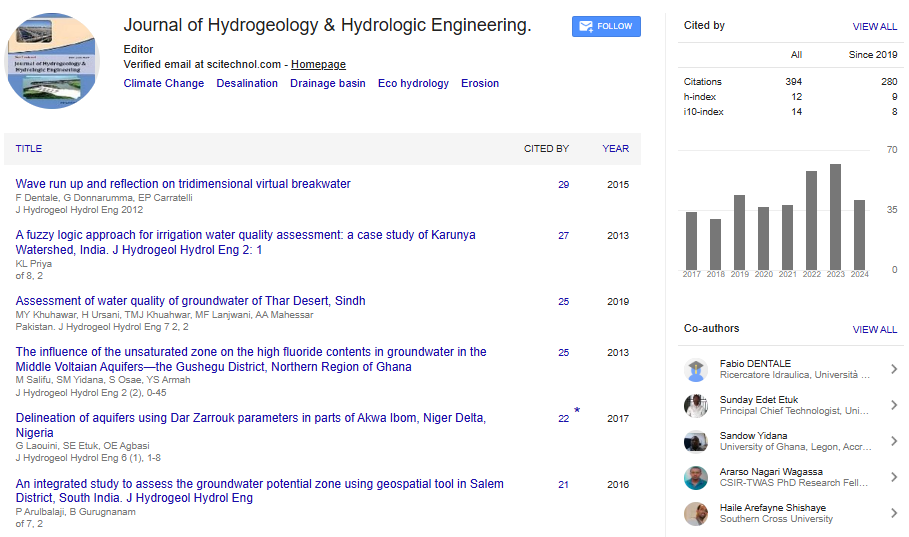Opinion Article, J Hydrogeol Hydrol Eng Vol: 13 Issue: 2
Discovering the Code of the World: The Revolutionary Potential of Remote Sensing
Puran Tripathy*
Department of Water Sciences, Beijing Normal University, Beijing, China
*Corresponding Author: Puran Tripathy,
Department of Water Sciences, Beijing
Normal University, Beijing, China;
E-mail: tripathyp36@gmail.com
Received date: 27 March, 2024, Manuscript No. JHHE-24-138805;
Editor assigned date: 29 March, 2024, PreQC No. JHHE-24-138805 (PQ);
Reviewed date: 12 April, 2024, QC No. JHHE-24-138805;
Revised date: 19 April, 2024, Manuscript No. JHHE-24-138805 (R);
Published date: 26 April, 2024, DOI: 10.4172/2325-9647.1000320
Citation: Tripathy P (2024) Discovering the Code of the World: The Revolutionary Potential of Remote Sensing. J Hydrogeol Hydrol Eng 13:2.
Description
In an age where technology reigns supreme, remote sensing stands as a testament to humanity's ability to explore, understand, and protect our planet like never before. With its roots in the empires of science fiction, remote sensing has evolved into a vital tool for researchers, conservationists, and policymakers alike. This article delves into the intricacies of remote sensing, exploring its applications, advancements, and the profound impact it has on our understanding of the world.
Remote sensing refers to the science of acquiring information about an object or phenomenon without making physical contact. Instead, it relies on the detection and measurement of electromagnetic radiation emitted, reflected, or diffracted by the object of study. This technology encompasses a diverse array of platforms, sensors, and techniques, ranging from satellites orbiting the Earth to drones balanced above its surface.
At the heart of remote sensing lies its ability to provide a comprehensive view of the Earth's surface, enabling scientists to monitor changes over time and space with unparalleled precision. From tracking deforestation in the Amazon rainforest to monitoring the health of coral reefs in the oceans, remote sensing offers insights into some of the most pressing environmental challenges facing our planet.
One of the most prominent applications of remote sensing is in the field of environmental monitoring and conservation. By capturing detailed images of the Earth's surface, remote sensing allows scientists to assess the health of ecosystems, identify areas of degradation, and monitor the impact of human activities on the environment. For example, satellite imagery can reveal the extent of urban sprawl or the loss of biodiversity in a particular region, providing valuable data for conservation efforts and land management practices.
Moreover, remote sensing plays an essential role in disaster management and response. By rapidly assessing the extent of damage caused by natural disasters such as earthquakes, hurricanes, or wildfires, remote sensing enables emergency responders to prioritize resources and coordinate relief efforts more effectively. Additionally, it facilitates the monitoring of environmental conditions that may contribute to the occurrence of disasters, allowing for early warning systems to be put in place.
In recent years, the field of remote sensing has witnessed significant advancements driven by technological innovation. The development of high-resolution sensors, coupled with advances in data processing and analysis techniques, has expanded the capabilities of remote sensing to new heights. For instance, the emergence of hyperspectral imaging allows researchers to capture detailed information about the composition of materials on the Earth's surface, opening up new possibilities for applications in agriculture, geology, and archaeology.
The integration of remote sensing with other technologies such as artificial intelligence and machine learning has revolutionized the way we interpret and analyze Earth observation data. By automating the process of image classification and feature extraction, these technologies enable researchers to extract meaningful insights from vast amounts of remote sensing data more efficiently than ever before. This synergy between remote sensing and artificial intelligence holds the potential to unlock new discoveries and address complex challenges facing our planet.
Looking ahead, the future of remote sensing holds immense promise, with ongoing efforts aimed at pushing the boundaries of what is possible. From the deployment of next-generation satellite constellations to the development of innovative sensor technologies, researchers continue to innovate and refine remote sensing techniques to meet the evolving needs of society. Moreover, the democratization of remote sensing data through open-access initiatives ensures that these valuable resources are accessible to scientists, policymakers, and citizens worldwide.
Conclusion
Remote sensing stands as an ideal of hope in our quest to understand and safeguard the planet we call home. By connecting the power of technology to observe the Earth from afar, remote sensing empowers us to address environmental challenges, manage natural resources, and respond to disasters with greater precision and efficiency. As we continue to explore the limits of remote sensing, We board on a journey of discovery that promises to unveil the mysteries of our world and shape a more sustainable future for generations to come.
 Spanish
Spanish  Chinese
Chinese  Russian
Russian  German
German  French
French  Japanese
Japanese  Portuguese
Portuguese  Hindi
Hindi 
